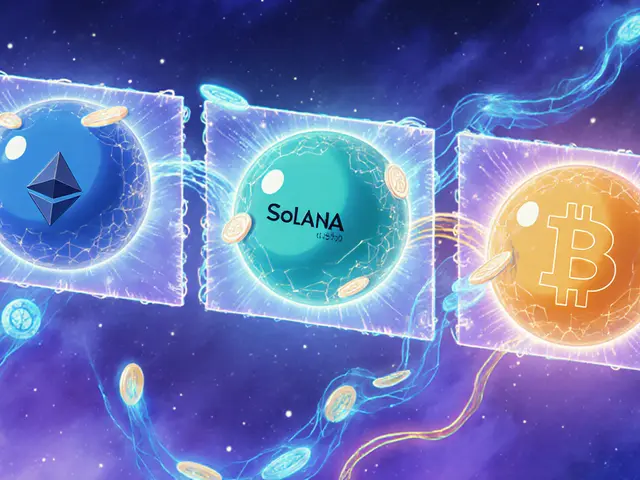Bifrost Liquid Staking Calculator
Estimated Returns
Original Staking Reward: $0.00
Boosted Staking Reward: $0.00
Total Estimated Return: $0.00
Equivalent vToken Value: 0.00 vTOKEN
Potential Annualized Return: 0.00%
Time to Break Even: 0 days
** bbBNC boost multipliers are approximate and may vary.
Ever wondered why your staked tokens can’t move while you’re earning rewards? Bifrost tries to solve that problem by turning staked assets into liquid tokens you can trade, borrow, or use in DeFi-without losing the staking yield. The answer to the title question lies in a blend of parachain tech, a native token (BNC), and a family of derivatives called vTokens. Below you’ll find everything you need to know, from the basics to the nitty‑gritty of how the protocol works, how to get started, and what to watch out for.
Quick Summary
- Bifrost is a Polkadot‑based liquid‑staking parachain that supports 15+ blockchains.
- The native BNC is a utility and governance token with a fixed supply of 80 million.
- Stakers receive vTokens derivatives that represent staked assets while staying 1:1 pegged, usable in DeFi.
- Additional yield options include bbBNC a boosted BNC staking token that earns extra rewards.
- As of Oct12025, BNC trades around $0.096 USD with a 24‑hour volume of $1.26M across 12 exchanges.
What Is Bifrost?
At its core, Bifrost (often abbreviated BNC) is a liquid‑staking protocol that lets users lock tokens on a proof‑of‑stake blockchain and receive a tradable representation of that stake. The protocol lives as a parachain on Polkadot and its sister network Kusama, inheriting the security guarantees of both relay chains. By operating as a dedicated parachain, Bifrost can offer native cross‑chain compatibility that most smart‑contract‑based staking solutions lack.
The team behind the project, Bifrost Finance, markets the platform as “The Staking Yield Layer.” This phrase captures two ideas: first, the protocol supplies a base layer of staking rewards; second, it feeds those rewards into higher‑level DeFi applications (trading, lending, leveraged positions) without requiring users to unstake.
How Does Liquid Staking Work on Bifrost?
When you stake an asset (for example DOT on Polkadot or KSM on Kusama), Bifrost locks the token in the appropriate validator set. In return, you receive a vToken such as vDOT or vKSM, which is a 1:1, yield‑bearing representation of your locked asset. The vToken can be sent to any DeFi protocol that accepts ERC‑20‑like tokens, giving you immediate liquidity.
Behind the scenes, the protocol’s Runtime Pallet tracks staking rewards on the native chain and continuously updates the value of the corresponding vToken. Because the vToken is pegged 1:1, there is no liquidation risk; the only variable is the accrued reward rate.
Key technical advantages include:
- No need to build separate staking integrations for each blockchain-developers plug into Bifrost’s standardized module once.
- Cross‑chain governance: vTokens retain voting power on their origin chain, a feature many competitors sacrifice.
- Modular design that can easily add new assets or chains via on‑chain referenda.

The Role of the BNC Token
The native token, BNC acts as the economic glue of the Bifrost ecosystem, serving three main functions:
- Transaction fees: All network fees-transfers, staking actions, and vToken minting-are paid in BNC. Fees are collected in a treasury that funds ongoing development.
- Staking collateral: Validators must lock BNC as a bond. The amount adjusts automatically based on performance, ensuring honest behavior.
- Governance: BNC holders can propose and vote on protocol upgrades via Polkadot’s democracy system. Voting weight is directly proportional to the amount of BNC owned.
Two derivative forms of BNC add extra yield opportunities:
- vBNC is a voting‑enabled BNC token that can be used in governance while earning staking rewards.
- bbBNC is a boosted version of BNC that locks the token for a higher APY, similar to a DeFi savings account.
With a capped supply of 80million tokens and a modest portion (≈2%) allocated to the Kusama parachain auction, scarcity could support price appreciation as adoption grows.
Getting Started with Bifrost
Here’s a step‑by‑step outline for a newcomer:
- Set up a Polkadot or Kusama wallet that supports the Polkadot.js interface (e.g., Talisman, Nova).
- Acquire the asset you want to stake (DOT, KSM, or any supported token) on an exchange that lists BNC, such as BingX or LBank.
- Connect your wallet to the Bifrost dashboard (bifrost.io the official web portal for staking and governance actions).
- Select the “Stake” tab, choose the asset, and enter the amount you wish to lock.
- Confirm the transaction. Bifrost will mint the corresponding vToken to your address.
- Deploy the vToken into your preferred DeFi app-Uniswap‑style DEXs, lending platforms, or yield farms.
While the process is simple, always double‑check the network fee in BNC and keep a small BNC balance for future governance voting.
Risks & Considerations
Liquid staking sounds like a free lunch, but there are trade‑offs:
- Smart‑contract risk: Although Bifrost runs as a parachain, the vToken minting logic is still a smart contract that could contain bugs.
- Validator performance: If the underlying validator set misbehaves, staking rewards may dip or, in extreme cases, slashing could occur.
- Liquidity risk: While vTokens are listed on many DEXs, market depth can vary. Large withdrawals may move the price.
- Regulatory outlook: Some jurisdictions treat liquid‑staking derivatives as securities. Check local rules before large investments.
Balancing the extra yield against these factors is key to a sustainable strategy.
How Bifrost Stacks Up Against Competitors
| Feature | Bifrost | Lido | Stafi |
|---|---|---|---|
| Parachain security | Yes (Polkadot/Kusama relay chain) | No (Ethereum smart contract) | No (Ethereum smart contract) |
| Multi‑chain support | 15+ blockchains | Ethereum, Solana, Terra (limited) | Ethereum, Polkadot (few) |
| vToken governance rights | Retained (cross‑chain) | Lost on most chains | Partial |
| Native utility token | BNC (fixed 80M) | LDO (inflationary) | FIS (inflationary) |
| Boosted staking option | bbBNC | None | None |
| TVL (Oct2025) | ~$250M | ~$1.2B | ~$180M |
In short, Bifrost shines for users who need true cross‑chain liquidity and want to keep voting power. If you are solely in the Ethereum ecosystem, Lido’s larger TVL might be more attractive, but you’ll sacrifice some decentralization features.

Frequently Asked Questions
What is a vToken and how is it different from the original token?
A vToken is a 1:1 minted representation of a staked asset. It carries the same economic value as the underlying token but also earns the staking reward automatically. Unlike the original token, a vToken can be moved and used in DeFi while the base asset stays locked on its native chain.
Do I need BNC to stake on Bifrost?
No. You can stake any supported asset (DOT, KSM, etc.). BNC is required only for paying transaction fees, acting as validator collateral, and participating in governance.
How can I earn extra yield with bbBNC?
Lock BNC into the bbBNC contract for a predefined period (usually 30‑90 days). The protocol then distributes a boosted APY on top of the standard staking reward. Exact rates are posted on the Bifrost dashboard and may change with network conditions.
Is Bifrost safe from hacks?
Bifrost benefits from Polkadot’s shared security model, meaning the relay chain validates its blocks. However, the vToken smart contracts are still code, so occasional audits are recommended. The team conducts regular third‑party audits and publishes reports on GitHub.
Can I unstake my assets at any time?
You can always redeem your vTokens for the underlying asset, but the unbonding period follows the native chain’s schedule (e.g., 28 days for Polkadot). During this time, the assets are locked but you keep any accrued rewards.
Got more questions? The Bifrost community on Twitter, Discord, and the official GitHub repository is pretty responsive and updates docs regularly.












Kate Roberge
July 28, 2025 AT 08:22 AMBifrost's whole hype train feels like another flash‑in‑the‑pan DeFi fad. Sure, multi‑chain liquid staking sounds slick, but the underlying tokenomics are still murky. You’re basically handing over your DOT or ETH to a bridge that promises higher yields, yet the risk of slashing or smart‑contract bugs remains. In my experience, the only safe play is to stick with native staking and avoid the extra layer of complexity.
Oreoluwa Towoju
August 4, 2025 AT 23:42 PMIf you’re looking for a quick overview, Bifrost lets you stake assets across chains while earning bbBNC boosts. Just remember the boost tiers and APY assumptions before you lock funds.
Jason Brittin
August 12, 2025 AT 15:02 PMOh great, another calculator to make us feel like we’re financial geniuses 😏. Plug in your numbers, watch the magic happen, and hope the protocol doesn’t pull a rug‑pull later 🙃.
Amie Wilensky
August 20, 2025 AT 06:22 AMWell…; the interface is certainly…; user‑friendly?; however, the real question-if any-remains: how sustainable are these boost multipliers?; the code audit…?; and what about the governance model?; these are not trivial concerns.
Lindsay Miller
August 27, 2025 AT 21:42 PMBifrost can be a handy tool for diversifying staking rewards, especially if you want exposure to multiple ecosystems without moving assets yourself. Just keep an eye on the rates and stay updated with any protocol news.
Katrinka Scribner
September 4, 2025 AT 13:02 PMCool tool, love the vibes 😊
Michael Wilkinson
September 12, 2025 AT 04:22 AMDon’t be fooled by the glossy UI-if the underlying validator set is compromised, you lose everything regardless of any bbBNC boost.
Carl Robertson
September 19, 2025 AT 19:42 PMPicture this: you’ve finally gotten your hands on a shiny BNC badge, the APR lights up like a neon sign, and then-boom-protocol governance freezes and your rewards evaporate. It’s a rollercoaster that could make even the most stoic investor spill their coffee.
Rajini N
September 27, 2025 AT 11:02 AMFor those planning to use the calculator, make sure to input the current market price of the asset, not just the USD amount, because the vToken conversion uses the real‑time token price. Also, remember that the boost multipliers are only applied after the base APY, so a 2.0x boost on a 12% APY yields 24%, not 36%.
MD Razu
October 5, 2025 AT 02:22 AMWhen we step back and examine the architecture of Bifrost, we encounter a layered construct that mirrors the very complexity of modern financial ecosystems.
The first layer, a conduit for staking native assets, promises liquidity that is almost too convenient to be believed.
Yet convenience, in the realm of decentralized finance, often carries an implicit cost that is hidden behind code that most users never audit.
The second layer, the bbBNC boost mechanism, introduces a variable multiplier that ostensibly rewards higher commitment, but in practice ties the user’s fate to governance decisions that may shift without warning.
One must consider the composability risk; each added protocol interaction compounds the attack surface.
Moreover, the token economics of BNC themselves are subject to supply inflation that can erode any nominal APY advantage over time.
For an investor who is risk‑averse, the marginal gain from a 1.5x boost may be offset by the opportunity cost of capital locked in a less transparent smart contract.
Historical precedent in the DeFi space shows that projects promising multi‑chain liquid staking often succumb to validator misbehaviour, slashing events, or governance capture.
The user interface, while sleek, does not convey the underlying stochastic variables that drive yield volatility.
If we model the expected return as a function of base APY, boost factor, and a volatility term, the confidence interval broadens dramatically as the boost factor increases.
Consequently, the advertised ‘potential annualized return’ can be a statistical illusion when the underlying assumptions are not disclosed.
A prudent approach involves conducting a sensitivity analysis, varying the input parameters to see how robust the projected returns are.
In addition, one must factor in transaction fees incurred when moving assets into and out of the Bifrost ecosystem, which can significantly cut into net profit.
There is also the consideration of network congestion on the host chains-Ethereum, Polkadot, Kusama-each of which can raise gas costs unpredictably.
Therefore, the decision to allocate capital to Bifrost should be predicated on a holistic risk assessment rather than a simplistic calculator output.
Only then can an investor claim to have truly internalized the multi‑dimensional risk profile inherent in multi‑chain liquid staking.
Charles Banks Jr.
October 12, 2025 AT 17:42 PMSure, let’s all trust a black‑box calculator to decide where our crypto lives; after all, who needs due diligence when you have a shiny UI?.
Ben Dwyer
October 20, 2025 AT 09:02 AMKeep experimenting with the tool, but always double‑check the numbers on a reputable explorer.
VICKIE MALBRUE
October 28, 2025 AT 00:22 AMLove the idea of earning more while staying flexible keep it up
Waynne Kilian
November 4, 2025 AT 15:42 PMIn a world where every chain chases liquid staking we find ourselves at a crossroad of convenience and risk – its a delicate balance that demands thoughtful deliberation.
Naomi Snelling
November 12, 2025 AT 07:02 AMThey probably don’t want you to notice the hidden fees baked into the boost algorithm, but you can see the pattern if you look closely.